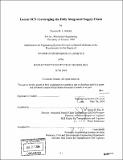Lucent SCN : leveraging the fully integrated supply chain
Author(s)
Scholtz, Duncan M. L. (Duncan Myndert L.), 1975-
DownloadFull printable version (5.328Mb)
Alternative title
Leveraging the fully integrated supply chain
Other Contributors
Massachusetts Institute of Technology. Engineering Systems Division.
Advisor
James B. Rice, Jr.
Terms of use
Metadata
Show full item recordAbstract
(cont.) in the success of Lucent's turnaround and, from the patterns that emerge, a basis for a new holistic framework for designing and leveraging an integrated supply chain is offered. This framework suggests that attaining competitive advantage from supply chain capabilities lies in a firm's ability to incorporate corporate culture, leadership style, organization structure and both inter and intra tier governance methods into it's supply chain design in order to enable an integrated and extended organization where the channel expert can be identified and engaged in decision making in a natural, real-time and organic process. Over the past three years, in response to dramatic changes in the telecommunications industry, Lucent Technologies has realigned its corporate strategy from being a provider of manufacturing excellence to one of supply chain excellence. Supported by this realignment, Lucent has recently returned to profitability after eleven consecutive losing quarters, and has posted dramatic improvements in financial, operational and customer satisfaction metrics. Lucent's new strategy is focused on leveraging its supply chain capabilities to create a new extended enterprise that is both customer and supplier intimate, and operates as a broad reaching cross-functional Supply Chain Networks (SCN) organization. Pivotal to the success of this realignment was extending the scope of Lucent's supply chain activities, both internally and externally to the company. Internally, Lucent integrated such non-traditional SCM activities as sales, product design, and margin management into its newly created SCN organization. Externally, by outsourcing virtually all of its manufacturing, and much of the associated supplier management, to Electronics Manufacturing Services (EMS) partners, Lucent became responsible for the orchestration of an extended multi-tier supply chain that integrated abilities and expertise of functional teams within Lucent and within its EMS partners, raw component suppliers and customers. In this thesis, the Supply Chain Networks transformation at Lucent is examined in the broader context of the changes that took place in Lucent's: organizational model; leadership team; corporate culture; customer and supplier relationships; operations; and market space. The change that was effected in each of these areas is reviewed for its role
Description
Thesis (M. Eng. in Logistics)--Massachusetts Institute of Technology, Engineering Systems Division, 2004. "June 2004." Includes bibliographical references (leaves 65-69).
Date issued
2004Department
Massachusetts Institute of Technology. Engineering Systems DivisionPublisher
Massachusetts Institute of Technology
Keywords
Engineering Systems Division.